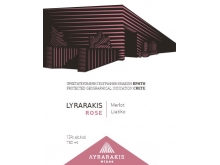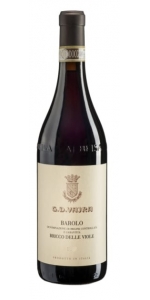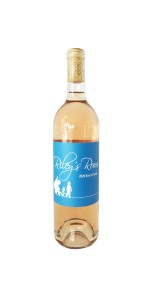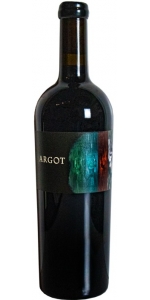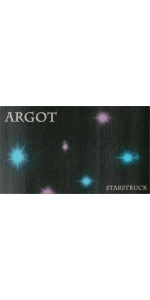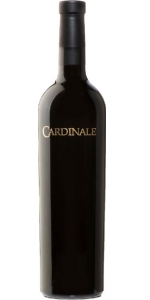Lyrarakis Liatiko Kedros Rose 2019
| Country: | Greece |
| Region: | Crete |
| Winery: | Lyrarakis Estate |
| Grape Type: | Merlot |
| Vintage: | 2019 |
| Bottle Size: | 750 ml |
G.D. Vajra Bricco Delle Viole Barolo is made from 100 percent Nebbiolo.
The Barolo Bricco delle Viole shows the signature verticality of its vineyard. The wine is beautifully layered and - while restrained as it’s always the case in the youth of Bricco delle Viole - it also shows a complexity of layers with purple flowers, sweet spices and mineral tones. The palate is noble, with a refined acid spine and profound tannins that promise a long aging potential.
Among the historical vineyards of Barolo, Bricco delle Viole is the highest and the closest to the Alps. It rises from 400 to 480 meters above sea level, on the Western ridge of the village. Its name, “Hill of Violets”, originates from the flowers that blossom early here due to the perfect south exposure. Up above the fogs, Bricco delle Viole enjoys the earliest sunrise and the last sunset every day. Thanks to its vines dating back to 1949 and -now- 1931, a dramatic diuturnal temperature range and this pure light, Bricco delle Viole generates a sophisticated and profound Barolo DOCG of bright aromatics, chiseled tannins and subtle minerality. 2018 is a vintage that shows many nuances of Bricco delle Viole: beyond the signature verticality of this site, the wine offers high tones laced with mineral nuances and plenty of energy and youth.
Review:
A juicy Barolo, with vibrant acidity and a fluid profile that exudes cherry, raspberry, mown hay, mineral and eucalyptus aromas and flavors. Tight yet long, with excellent potential.
#26 Wine Spectator Top 100 of 2023
The last wine poured at my tasting at the winery is the G.D. Vajra 2019 Barolo Bricco delle Viole. With its high vantage point in the hills west of Barolo, Bricco delle Viole is a world apart in terms of soils (with Sant'Agata marl and fossils) and even harvest times. Slow and careful ripening like the kind that characterizes fruit in 2019 renders a very delicate and ethereal expression with floral tones, wild mint and licorice. This organic wine is solid in build and structure. Indeed, Isidoro Vaira remarks that Nebbiolo tannins have changed since the 1970s and 1980s.
-Wine Advocate 97+ Points
Jeweled in appearance, the 2019 Barolo Bricco Delle Viole may be the best wine I have tried yet from Vajra. Its gorgeous and alluring perfume of fresh roses is followed by a Burgundian, elegant red with incredible length and no harsh edges, fine and present tannins, and beautiful, graceful concentration. It is drinking well now, and I will be trying to get my hands on as much of this as possible. Drink 2025-2045.
-Jeb Dunnuck 97 Points
Rileys Rows Rose of Syrah is made from 100 percent Syrah.
When I think about my rosé one word comes to mind: intentional. Made from 100% syrah and pressed off skins in the Provencal style this wine is not just an afterthought. Typically picked in mid-October from a cool climate site the fruit comes in with both chemical and flavor ripeness. The result is a low alcohol, fresh wine with a complete flavor profile
Argot Cabernet Sauvignon 1555 Oakville is made from 100% Cabernet Sauvignon.
Hailing from the historic Bonny’s Vineyard in the heart of Oakville. Cabernet Sauvignon vines thrive in the gravel rich soils here adjacent to the Napa River riverbed. Roots plumb deep into the valley floor, while vine canopies harvest Napa Valley’s plethora of summer sunshine. These conditions conspire to deliver unerringly perfect Cabernet Sauvignon grapes.
Pouring a deep opaque red-violet, 1555’s Cabernet personality leaps from the glass balancing opulent fruit, damp earth, chilling minerality and an alluring spice note that keeps pulling us back for more. Exquisitely ripe tannins provide a refined, velvety structure, delivering the deep and seductively rich palate. The pedigree displayed in the glass is undeniable.
Review:
"Deep garnet-purple in color, the 2019 Cabernet Sauvignon 1555 Oakville wafts sensuously out of the glass with redcurrant jelly, black raspberries and rose oil scents, followed by a cassis and black plums core, with emerging suggestions of cinnamon toast, cedar and pencil shavings. The full-bodied palate is fantastically fragrant, delivering red and black fruit layers accented by floral and exotic spice nuances, supported by super ripe, velvety tannins, finishing long and perfumed. 250 cases were made. - Lisa Perrotti-Brown"
- Robert Parker's Wine Advocate (November 2021), 95+ pts
Argot Starstruck Cabernet Sauvignon is made from 90% Cabernet Sauvignon, 10% Merlot (15-25 years old)
An explosive nose of Cabernet—singular only to the Napa Valley—introduces the 2019 Starstruck with classically elegant red and black Cabernet fruits, enhanced by notes of smoked sage and rosemary. Red-fruits carry the mid-palate, dancing on a pillow of wonderfully sweet tannin and pie spice complexity. As the wine transitions from the mid, acid emerges lifting Starstruck's massive palate into a warming finish that continues to reveal dark fruits and intriguing spice accents. A gorgeous Cabernet that remains approachable, while its structure and earthy complexities keep bombast at bay.
Review:
The 2019 Cabernet Sauvignon Starstruck has a classic Napa Valley Cabernet nose of crème de cassis, violets, lead pencil, and flowery incense. This carries to a medium-bodied, supple, nicely textured Cabernet with moderate tannins, terrific overall balance, and a great finish. It's ready to go and should keep for 10-12 years or more.
-Jeb Dunnuck 92 Points
Benjamin Romeo La Cueva del Contador is made from 91% Tempranillo, 9% Garnacha.
Named after the centuries-old caves or “cuevas” carved out of the hillside below the castle of San Vicente in Sonsierra north of the Ebro, this wine is composed of 91 percent Tempranillo and 9 percent Garnacha. The fruit is sourced from eight different plots that yield about 1.2 kg per vine. Fermentation begins after a three-day cold maceration and the wine is aged for nineteen months in 100 percent new French oak and bottled without fining or filtration.
The palate offers flavors of blackberry coulis, Damson plums, Rosemary and well-integrated tannins; this wine is well balanced and youthful with a long powerful finish. Both red and black fruit are pronounced in the nose, but there are also mineral and herbal notes of gravel and lavender.
Review:
I found cleaner aromas and a fresher quality and finer tannins in the 2019 La Cueva del Contador, a quite complete wine with elegance and finesse combined with power and concentration. The oak is still noticeable after 18 months in new barriques, and I'd wait a little longer before pulling the cork. It has the perfume of La Cueva in the background. It should resurface with a little more time in bottle. 10,000 bottles produced.
-Wine Advocate 95 Points
Cardinale Napa Valley Cabernet Sauvignon is made from 91% Cabernet Sauvignon, 9% Merlot.
Super structured and with minerality to spare, this Cabernet Sauvignon offers a real presence on the palate from start to finish. Generous notes of dark chocolate balance beautifully with a blue and black fruit flavor explosion, finishing with a subtle whisper of rose petal.
Reviews:
- James Suckling 98 Points
-Jeb Dunnuck 98+ Points
Lyrarakis Liatiko Kedros Rose is made from 75% Merlot, 25% Liatiko.
Grapes are carefully selected by hand at optimum phenolic and aromatic maturity. After being destemmed, the free run juice is fermented in a stainless steel tank at controlled temperatures.
The wine is produced in the Alagni area, central Crete, from vineyards located 480 meters above sea level.
Light coral color. The nose offers typical Mediterranean aromas composed of a variety of scents like red fruits and blossomy herbs. The palate is silky and fresh with a long flavorful aftertaste of strawberry marmelade.
The Lyrarakis Estate is a family winery which has been producing high quality wines since 1966 with a strong focus on rare local varieties and producing single variety wines.
The family is credited with the revival of two ancient Cretan varieties, Dafni and Plyto while a third “vineyard treasure”, the indigenous Melissaki, is recently added to the credits.
Surrounded by the idyllic setting of the vineyards and the Lassithi mountains we offer you the opportunity to enjoy nature and discover local varieties and wines distinguished by the uniqueness of their origin and heritage.
The founders of the Lyrarakis Estate decided 40 years ago to get actively involved with winemaking in their native land. The company now known as GEA (Alagni Agricultural Enterprises) was founded in 1966. The family has always used its privately owned vineyards. At that time, the dominant varieties included Vilana, Kotsifali and Mantilaria. After careful selection of the Vilana strain, the first organised planting of this particular variety was completed and served to supply the farmers of the region. But the family’s grape-growing did not stop there. In the late 1980s, there was an attempt to save two rare native varieties, Dafni and Plyto, from the Phylloxera blight. Efforts were ultimately successful as indicated by the wines of the same name first made available by the Lyrarakis company in the early 1990s.
The village of Alagni, from which the Lyrarakis family originated, is located in the heart of Heraklion Prefecture, in the most mountainous area of Crete’s Peza region with the extensive wine-producing tradition (stone-carved wine presses from the Venetian era are scattered throughout the region).
Today, the family vineyard is 15 hectares (37 acres) and produces seven single-variety wines from native grape varieties: The selection of products is rounded off with combined vinification of native and foreign varieties, the best-known of which include Kotsifali-Syrah and Cabernet-Merlot.
- back
Paul Hobbs West Sonoma Coast Pinot Noir is made from 100 percent Pinot Noir.
Hailing from the newly established West Sonoma Coast AVA,.
Lovely ruby red shades catch the eye, while exotic notes of tart Morello cherry and pungent pine forest swirl with fresh raspberry. Bright, pure fruit carries through on the palate, layered with earthy hints of damp loam and rocky salinity, all backed by the elegant, fine-grained tannins and stylish grip that cool West Sonoma Coast offers at its best.
Review:
A rush of sugared beet, pomegranate, and vanilla-soaked raspberry mingles with a touch of salinity on entry, while a soil component reflects the super-cool climate of the appellation. Power and elegance coexist in this red, which finishes with graphite, peony, basil, and exotic incense.
-Tasting Panel 97 Points
The Prisoner Wine Co. Blindfold Chardonnay is made from 100 percent Chardonnay.
Blindfold Chardonnay is gorgeously balanced and a true triumph. Fragrant with notes of lime zest, yuzu, jasmine, and a slight minerality, Bright on the palate with juicy green citrus, lychee, green apple and toasted hazelnut. You’ll find both freshness and soft texture from its time in oak. The finish is long and indulgent–let yourself sink into this luxurious pour.
All of the fruit was hand-picked and whole cluster pressed. Barrel fermentation took place in 100% French oak barrels, and 23% New barrels that were selected by forest or grain tightness to frame our fruit profile, bring texture, and soften acidity. Lots were tasted every other week while we stirred the lees to precisely soften the mouthfeel and achieve optimal balance. With fermentation, and subsequent elevage taking place over 11 months we have achieved this goal.
Chardonnay grapes were harvested as flavors of lime zest and green apple started to develop and before acid started to ripen away. Picking decisions were made based on acidity rather than sugar level (Brix). We want to showcase the vineyard sites and growing region in perfect balance.

